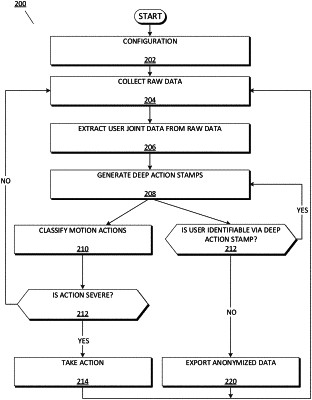| CPC G06F 21/6263 (2013.01) [G06F 18/24 (2023.01); G06V 40/20 (2022.01)] | 20 Claims |

|
1. A method for privacy-preserving motion analysis, the method comprising:
collecting data corresponding to a user with one or more sensors;
identifying one or more joints of the user based on the data;
generating one or more 3D representations of the one or more joints of the user;
anonymizing the one or more 3D representations by applying thereto a joint-centering and a random shuffling;
classifying one or more actions of the user based on analysing the one or more 3D representations, wherein the classifying outputs a predicted action score;
determining whether an identity of the user can be reverse engineered from the one or more 3D representations, wherein the determining outputs a predicted privacy-preservation score; and
based on determining that the identity of the user cannot be reverse engineered from the one or more 3D representations, exporting at least one of the data and the one or more actions.
|